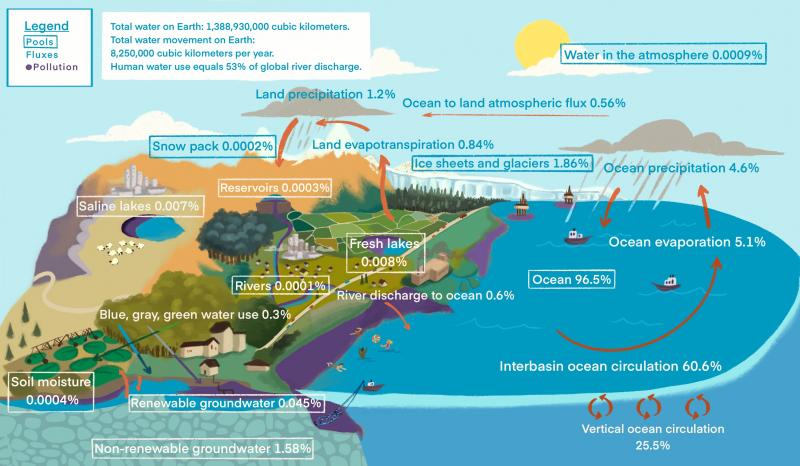Introduction

Detailed water cycle
CC SA: LangeLeslie, https://en.wikipedia.org/wiki/File:HumanIntegratedWaterCycle_(2).jpg
All the water that is on our planet has been here since the beginning of life on earth… This means that every droplet of water must be constantly reused and passed around the planet to accommodate water’s many roles worldwide.
So where does our water travel on its long journey to our taps? How is water constantly being reused and transported around the globe?
We will create a text adventure game that will teach you these topics.
Task

The Zork Adventure Game
cc-by-2.0. Marcin Wichary, https://en.wikipedia.org/wiki/File:Zork_photo.jpg
Create a text adventure game for the journey of a water droplet as it moves through the various stages of the water cycle using embedded if statements.
You will learn Python coding, some theory about games and making a game, and a lot of interesting information about water: what is water cycle, what are clouds, or what is snow? How the water evaporates though it is not boiling? Page 4 (The water cycle, see the document level 2 - water cycle text adventure game.pdf) is a very detailed view of the water cycle. Use that to find out how the water flows in the globe. The next page, page 5, show a simplified version of the same process.
However, at the same time you should consider what is a game, and how to combine all different gaming paths to a single computer program. The hero of the game is a small water droplet, whose journey we are going to explore. You can follow the statements given here, or create and add some more variety to the program. You should include the physics, chemistry, biology and geography and also use proper terminology. This exercise really integrates many substances into one.
Process
We create a program that should:
- Ask the user a series of questions to create an individual story for the journey of a water droplet, depending on the options entered by the user
- Give the user the option to repeat the questioning after ‘the water has returned to the cloud’
- Create the first subroutine given at page 9.
- Write the main program (page 10). We will use a lot of if statements and loops. Those are explained in the pdf document.
- Create the game using loops and if then else commands. An example is given on page 12, 13 and 14.
- Compare your code with that on page 14-15 (step 4). There is one example but your game should not be identical.
Conclusion
- You should know that gaming is an important topic.
- Using this exercise you can create fun and interactive stories, and also learn the water cycle.
- You should be able to use this exercise to create similar game of eg. carbon cycle, or create a pure adventure text game, as Zork.
Next steps:
- Watch the videos given on the Links, and find out more information about text adventure games. Those are a living sub genre of computer games.
- Play Zork. Zork is one the first text games ever created. See how elaborated that is.
- Find out how to parse the text given by user and how computer understands written language.
- Use your favourite search engine to find out more about the water cycle.
- Move to Level 3: Java programming.
Links to everyday life:
- The movement of water is extremely important for the life.
- The amount of water is about the same: we do not get more water into the globe or lose the water into the space.
- The cleaning of water is done during the water cycle, but also humans have created machines to clean water.
Learning Objectives
Learning Objectives
- You can use embedded if statements with confidence.
- You know what is the water cycle.
- You can make and call a (procedure) subroutine.
- You know what are water reservoirs.
- You can use a while loop .
- You know the important of water?
- You can use the print and input function with confidence.
- You know differences between the saline and fresh water.
- You know how name variables with appropriate names that make sense in the code.
- You are familiar how the nature purifies water.






